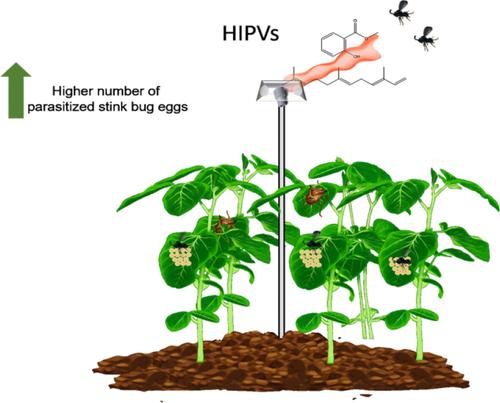当前位置:
X-MOL 学术
›
Pest Manag. Sci.
›
论文详情
Our official English website, www.x-mol.net, welcomes your feedback! (Note: you will need to create a separate account there.)
Attracting Scelionidae egg parasitoids to enhance stink bug egg parasitisation in soybean crops using methyl salicylate and (E,E)‐α‐farnesene
Pest Management Science ( IF 3.8 ) Pub Date : 2024-06-29 , DOI: 10.1002/ps.8274 Mirian Fernandes Furtado Michereff 1 , Diego Martins Magalhães 1 , Izabela Nunes do Nascimento 1 , Raúl Alberto Laumann 1 , Miguel Borges 1 , David Matthew Withall 2 , Michael Alexander Birkett 2 , Maria Carolina Blassioli-Moraes 1
Pest Management Science ( IF 3.8 ) Pub Date : 2024-06-29 , DOI: 10.1002/ps.8274 Mirian Fernandes Furtado Michereff 1 , Diego Martins Magalhães 1 , Izabela Nunes do Nascimento 1 , Raúl Alberto Laumann 1 , Miguel Borges 1 , David Matthew Withall 2 , Michael Alexander Birkett 2 , Maria Carolina Blassioli-Moraes 1
Affiliation

|
BACKGROUNDPlant volatile organic compounds (VOCs) play a crucial role in mediating interactions between plants, herbivores and natural enemies. Among these VOCs, methyl salicylate and (E ,E )‐α‐farnesene are emitted as herbivore‐induced plant volatiles (HIPVs) by soybean plants in response to feeding by the brown stink bug Eushistus heros . These HIPVs function as synomones, influencing the foraging behaviour of the egg parasitoid, Telenomus podisi , the main natural enemy of E . heros , one of the major soybean pests in Brazil.RESULTSLaboratory experiments showed that two soybean cultivars, BRS 7580 and BRS 7880, produced similar qualitative blends of HIPVs, with methyl salicylate, (E ,E )‐α‐farnesene and (Z )‐3‐hexenyl acetate being produced by both cultivars. Soybean cultivar BRS 7580 produced a significant lower amount of HIPVs compared to BRS 7880 but this difference did not affect the attractiveness of the egg parasitoid Telenomus podisi . Field experiments using these two cultivars and synthetic applications of methyl salicylate and (E ,E )‐α‐farnesene showed a substantial increase in egg parasitism in all treated areas. Parasitism rates ranged from 50% to 80% in areas where these HIPVs were deployed, compared to only 10% in untreated control areas.CONCLUSIONSThe egg parasitoid Telenomus podisi demonstrated an adept ability in recognising between HIPVs in soybean blends, even in the presence of significant quantitative differences. The results from the field experiment showed the potential of HIPVs in attracting natural enemies to specific target areas within fields. (E ,E )‐α‐Farnesene showed an improved action during the later stages of soybean growth, notably at R6. In addition, this volatile attracted other families of natural enemies. © 2024 Society of Chemical Industry.
中文翻译:

使用水杨酸甲酯和 (E,E)-α-法呢烯吸引黄蜂卵寄生蜂以增强大豆作物中臭虫卵的寄生
背景植物挥发性有机化合物(VOC)在调节植物、食草动物和天敌之间的相互作用中发挥着至关重要的作用。在这些挥发性有机化合物中,水杨酸甲酯和(乙,乙)-α-法呢烯作为草食动物诱导的植物挥发物 (HIPV) 被大豆植物释放,以响应褐蝽的取食尤什图斯英雄。这些 HIPV 作为共轭体发挥作用,影响卵寄生蜂的觅食行为,波氏竹蛾,主要天敌乙。英雄,巴西的主要大豆害虫之一。 结果实验室实验表明,两个大豆品种 BRS 7580 和 BRS 7880 产生了相似质量的 HIPV 混合物,其中含有水杨酸甲酯,(乙,乙)-α-法呢烯和( Z两个品种均产生 )-3-乙酸己烯酯。与 BRS 7880 相比,大豆品种 BRS 7580 产生的 HIPV 数量明显较低,但这种差异并不影响卵寄生蜂的吸引力波氏竹蛾。使用这两个品种的田间试验以及水杨酸甲酯和(乙,乙)-α-法呢烯在所有治疗区域中的虫卵寄生率均显着增加。在部署这些 HIPV 的地区,寄生率从 50% 到 80% 不等,而未经治疗的对照地区仅为 10%。 结论 卵寄生蜂波氏竹蛾即使存在显着的数量差异,也表现出了识别大豆混合物中 HIPV 的熟练能力。 田间实验的结果显示了 HIPV 在吸引天敌到田间特定目标区域方面的潜力。 (乙,乙)-α-金合欢烯在大豆生长后期(特别是在 R6 阶段)显示出改善的作用。此外,这种不稳定还吸引了其他家族的天敌。 © 2024 化学工业协会。
更新日期:2024-06-29
中文翻译:

使用水杨酸甲酯和 (E,E)-α-法呢烯吸引黄蜂卵寄生蜂以增强大豆作物中臭虫卵的寄生
背景植物挥发性有机化合物(VOC)在调节植物、食草动物和天敌之间的相互作用中发挥着至关重要的作用。在这些挥发性有机化合物中,水杨酸甲酯和(乙,乙)-α-法呢烯作为草食动物诱导的植物挥发物 (HIPV) 被大豆植物释放,以响应褐蝽的取食尤什图斯英雄。这些 HIPV 作为共轭体发挥作用,影响卵寄生蜂的觅食行为,波氏竹蛾,主要天敌乙。英雄,巴西的主要大豆害虫之一。 结果实验室实验表明,两个大豆品种 BRS 7580 和 BRS 7880 产生了相似质量的 HIPV 混合物,其中含有水杨酸甲酯,(乙,乙)-α-法呢烯和( Z两个品种均产生 )-3-乙酸己烯酯。与 BRS 7880 相比,大豆品种 BRS 7580 产生的 HIPV 数量明显较低,但这种差异并不影响卵寄生蜂的吸引力波氏竹蛾。使用这两个品种的田间试验以及水杨酸甲酯和(乙,乙)-α-法呢烯在所有治疗区域中的虫卵寄生率均显着增加。在部署这些 HIPV 的地区,寄生率从 50% 到 80% 不等,而未经治疗的对照地区仅为 10%。 结论 卵寄生蜂波氏竹蛾即使存在显着的数量差异,也表现出了识别大豆混合物中 HIPV 的熟练能力。 田间实验的结果显示了 HIPV 在吸引天敌到田间特定目标区域方面的潜力。 (乙,乙)-α-金合欢烯在大豆生长后期(特别是在 R6 阶段)显示出改善的作用。此外,这种不稳定还吸引了其他家族的天敌。 © 2024 化学工业协会。
















































 京公网安备 11010802027423号
京公网安备 11010802027423号